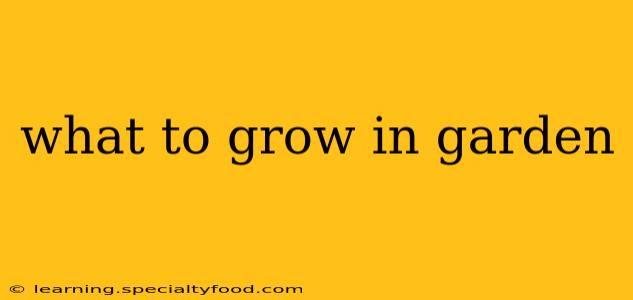Deciding what to grow in your garden can feel overwhelming! With so many options available, it's easy to get lost in the possibilities. This guide will help you navigate the choices, considering your climate, experience level, and personal preferences to create a thriving and rewarding garden.
What are the best vegetables to grow?
This depends heavily on your climate and growing season. However, some reliably easy-to-grow vegetables for beginners include:
- Lettuce: Quick-growing and relatively low-maintenance, lettuce offers a fast harvest and a variety of textures and flavors.
- Radishes: Another fast-growing option, radishes are perfect for impatient gardeners and add a spicy crunch to salads.
- Zucchini: Prolific producers, zucchini plants can quickly overwhelm you with their abundance, but their ease of care makes them a popular choice.
- Beans (bush beans): Bush beans are less demanding than pole beans and offer a steady supply of fresh beans.
- Cherry tomatoes: These smaller tomatoes are less prone to splitting and are perfect for snacking or adding to salads.
What are the easiest flowers to grow?
For beginner gardeners, some low-maintenance, high-impact flowers include:
- Sunflowers: These cheerful giants are incredibly easy to grow from seed and are a favorite among children.
- Zinnias: Bright and colorful, zinnias are drought-tolerant and bloom profusely throughout the summer.
- Marigolds: Known for their pest-repelling properties, marigolds are also low-maintenance and add a vibrant touch to any garden.
- Nasturtiums: These edible flowers are beautiful and add a peppery zest to salads and other dishes.
- Petunias: These versatile flowers come in a wide array of colors and are relatively easy to care for.
What should I consider when choosing plants for my garden?
Several key factors should influence your plant selection:
- Your climate: Choose plants that thrive in your specific hardiness zone and can tolerate the average temperatures, rainfall, and sunlight in your area. Check with your local agricultural extension office for specific recommendations.
- Sunlight: Different plants require varying amounts of sunlight. Observe your garden throughout the day to determine how much sun each area receives.
- Soil type: Test your soil to determine its pH and nutrient levels. This will help you choose plants that will flourish in your soil conditions. Amend your soil as needed to improve drainage or add nutrients.
- Space available: Consider the size of your garden and choose plants that will fit comfortably without overcrowding. Check the mature size of each plant before planting.
- Your experience level: Start with easy-to-grow varieties if you're a beginner. As you gain experience, you can gradually challenge yourself with more demanding plants.
- Your personal preferences: Ultimately, the best plants for your garden are the ones you enjoy the most! Choose plants whose colors, scents, and textures appeal to you.
What herbs are easy to grow?
Herbs are a fantastic addition to any garden, offering culinary delights and often requiring minimal care. Popular easy-to-grow herbs include:
- Basil: A staple in Italian cooking, basil thrives in warm, sunny locations.
- Mint: A vigorous grower, mint can quickly spread, so it's best grown in a container.
- Cilantro: A cool-season herb, cilantro is best planted in spring or fall.
- Parsley: A hardy herb, parsley can tolerate some shade.
- Chives: These clump-forming herbs are easy to divide and replant.
What fruits and vegetables can I grow together?
Companion planting can benefit your garden by attracting beneficial insects, deterring pests, or improving soil conditions. Research companion planting guides specific to your chosen plants for optimal results. For instance, basil is often planted near tomatoes to deter pests.
By considering these factors and starting with a few easy-to-grow options, you can create a beautiful and productive garden that you'll enjoy for years to come. Remember to research specific plant needs and adjust your approach based on your unique garden conditions and personal preferences. Happy gardening!
